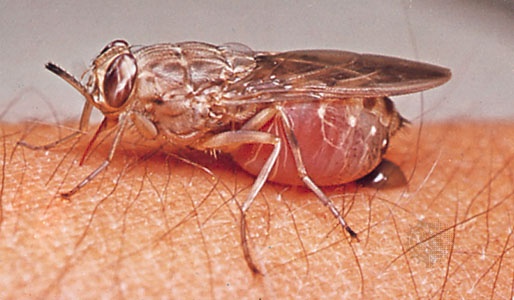tsetse fly
insect
 any member of a genus of bloodsucking flies in the housefly family, Muscidae (order Diptera), that occur only in Africa and transmit sleeping sickness in humans. They also transmit a similar disease called nagana in domestic animals. Tsetse flies have mandibles modified into bladelike structures used to pierce skin. They readily feed on the blood of humans, domestic animals, and wild game. The widespread presence of the tsetse has inhibited human settlement and agriculture in large areas of sub-Saharan Africa.
any member of a genus of bloodsucking flies in the housefly family, Muscidae (order Diptera), that occur only in Africa and transmit sleeping sickness in humans. They also transmit a similar disease called nagana in domestic animals. Tsetse flies have mandibles modified into bladelike structures used to pierce skin. They readily feed on the blood of humans, domestic animals, and wild game. The widespread presence of the tsetse has inhibited human settlement and agriculture in large areas of sub-Saharan Africa.All 21 tsetse species are similar in appearance. They are robust, sparsely bristled flies that are usually larger than their relative, the housefly. They range from 6 to 16 mm (0.2 to 0.6 inch) in length. Tsetses are rather drab in appearance, with colour varying from yellowish brown to dark brown, and with a gray thorax that often has dark markings. The abdomen may be banded. The stiff, piercing mouthparts, directed downward as the fly bites, are held horizontally at other times. While resting, the wings are held flat over the back. A bristlelike appendage (arista) on each antenna bears one row of long, branched hairs, differentiating the tsetse fly from all other flies.
Tsetse fly adults may live from one to three months. The larva hatches from an egg within the female, and the young develop singly within the female's uterus, feeding on a nutrient fluid secreted by paired milk glands on her uterine wall. The ensuing three stages of larval growth require about nine days. Without a sufficient blood meal, the female fly will produce a small, underdeveloped and nonviable larva. However, when adequately fed, she will produce a fully matured larva about once every 10 days throughout her life. After the larva is deposited on the ground, it burrows into the soil and pupates within an hour. Adults emerge after several weeks.
In general, tsetse flies occur in woodlands, though they may fly out a short distance into open grasslands when attracted by a host animal. The medically important species Glossina palpalis occurs primarily in dense streamside vegetation, while G. morsitans, feeds in more open woodlands. Both sexes suck blood almost daily, especially during the warmest part of the day. Most tsetse species cease activity soon after sunset, or at temperatures below 15.5° C (60° F). Of the tsetse flies that attack humans, 80 percent or more may be males; the females usually attack larger animals.
Only two species of tsetse flies commonly transmit the flagellate protozoan parasites (trypanosomes) that cause human sleeping sickness. The tsetse G. palpalis is the chief carrier of the parasite Trypanosoma brucei gambiense, which causes sleeping sickness throughout western and central Africa. G. morsitans is the chief carrier of T. brucei rhodesiense, which causes sleeping sickness in the highlands of eastern Africa. G. morsitans also carries the trypanosomes that cause nagana.
The most effective controls of the flies have been environmental ones: destruction of the wild game upon which the flies feed, clearing of woodlands, and periodic burning to prevent the growth of brush. Trapping of flies, control by natural parasites, and the spraying or other application of insecticides usually reduce fly populations in a locality but have difficulty eliminating them altogether. An alternative method is the introduction of large numbers of sterilized (sterilization) male tsetse flies into a wild population. Exposure to gamma radiation in laboratory facilities renders the flies sterile but does not interfere with their ability to mate. The sterile males' unions with females produce no offspring, and since female tsetse flies mate only a single time in life, those that mate with sterile males are themselves rendered sterile, for all practical purposes. The method has been found to totally eradicate tsetse flies in localities where their populations have already been significantly reduced by conventional methods.
- Henri Carton de Wiart, Comte
- Henri Charrière
- Henrician Articles
- Henric Laurenszoon Spieghel
- Henri Cochet
- Henri Coiffier de Ruzé Cinq-Mars, marquis de
- Henri Coiffier de Ruzé, marquis de Cinq-Mars
- Henri, Comte Carton de Wiart
- Henricus Glareanus
- Henri de Boulainvilliers, comte de Saint-Saire
- Henri de, comte de Saint-Saire Boulainvilliers
- Henri de La Tour d'Auvergne Turenne, vicomte de
- Henri de La Tour d'Auvergne, vicomte de Turenne
- Henri de Lorraine, Count de Harcourt
- Henri de Lorraine Harcourt, Count de
- Henri de Massue Galway, Marquis de Ruvigny et Raineval
- Henri de Massue, Marquis de Ruvigny et Raineval Galway
- Henri de Régnier
- Henri de Saint-Simon
- Henri de Tonty
- Henri de Toulouse-Lautrec
- Henri, duc de Rohan
- Henri Dunant
- Henri Duparc
- Henri Dutilleux